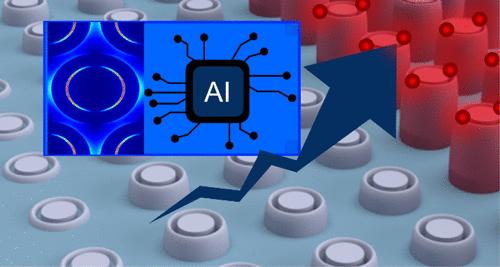当前位置:
X-MOL 学术
›
J. Phys. Chem. C
›
论文详情
Our official English website, www.x-mol.net, welcomes your feedback! (Note: you will need to create a separate account there.)
Machine Learning-Assisted Light Management and Electromagnetic Field Modulation of Large-Area Plasmonic Coaxial Cylindrical Pillar/Ring Nanoarray Patterns
The Journal of Physical Chemistry C ( IF 3.3 ) Pub Date : 2024-06-18 , DOI: 10.1021/acs.jpcc.4c01405 Anyang Wang 1 , Yingjie Hang 1 , Jiacheng Wang 1 , Weirui Tan 1 , Nianqiang Wu 1
The Journal of Physical Chemistry C ( IF 3.3 ) Pub Date : 2024-06-18 , DOI: 10.1021/acs.jpcc.4c01405 Anyang Wang 1 , Yingjie Hang 1 , Jiacheng Wang 1 , Weirui Tan 1 , Nianqiang Wu 1
Affiliation

|
Hexagonal coaxial cylindrical gold pillar/ring nanoarray patterns can be fabricated with an anodic aluminum oxide (AAO) template or nanosphere lithography. It is time-consuming and expensive for experimental work solely to tune and optimize geometrical parameters for achieving desirable optical properties. Herein, finite-difference time-domain (FDTD) simulation has been performed to investigate how the key geometrical parameters govern optical properties such as plasmonic resonance band, local electric field enhancement, and quality factor (Q-factor). FDTD simulation results reveal that these three important optical properties can be modulated by coupling localized surface plasmon resonance (LSPR) and charge distributions on the metal–dielectric interface to suppress its radiative damping, concentrate the electric field, and tune a spectral resonance. The impact of specific geometric parameters on optical properties was further analyzed via machine learning for visualization. For the gold pillar/ring nanoarrays, the local electric field enhancement can occur at the gap between two adjacent nanostructures or at the gap between pillar and ring. Adjusting the height and gap width proves to be the most effective to optimize both the Q-factor and electric field enhancement. These machine learning-assisted studies will provide a theoretical framework for tailoring the geometrical parameters of the coaxial cylindrical pillar/ring nanoarray patterns toward desirable optical properties.
中文翻译:

大面积等离激元同轴圆柱形柱/环纳米阵列图案的机器学习辅助光管理和电磁场调制
六边形同轴圆柱形金柱/环纳米阵列图案可以使用阳极氧化铝(AAO)模板或纳米球光刻来制造。仅通过调整和优化几何参数来实现理想的光学性能的实验工作既耗时又昂贵。在此,进行了时域有限差分 (FDTD) 仿真,以研究关键几何参数如何控制光学特性,例如等离子体共振带、局部电场增强和品质因数 (Q 因子)。 FDTD 模拟结果表明,这三个重要的光学特性可以通过耦合局域表面等离子体共振 (LSPR) 和金属-电介质界面上的电荷分布来调节,以抑制其辐射阻尼、集中电场并调整光谱共振。通过机器学习可视化进一步分析特定几何参数对光学特性的影响。对于金柱/环纳米阵列,局部电场增强可以发生在两个相邻纳米结构之间的间隙或柱与环之间的间隙处。事实证明,调整高度和间隙宽度是优化 Q 因子和电场增强的最有效方法。这些机器学习辅助的研究将为调整同轴圆柱/环纳米阵列图案的几何参数以获得所需的光学特性提供理论框架。
更新日期:2024-06-21
中文翻译:

大面积等离激元同轴圆柱形柱/环纳米阵列图案的机器学习辅助光管理和电磁场调制
六边形同轴圆柱形金柱/环纳米阵列图案可以使用阳极氧化铝(AAO)模板或纳米球光刻来制造。仅通过调整和优化几何参数来实现理想的光学性能的实验工作既耗时又昂贵。在此,进行了时域有限差分 (FDTD) 仿真,以研究关键几何参数如何控制光学特性,例如等离子体共振带、局部电场增强和品质因数 (Q 因子)。 FDTD 模拟结果表明,这三个重要的光学特性可以通过耦合局域表面等离子体共振 (LSPR) 和金属-电介质界面上的电荷分布来调节,以抑制其辐射阻尼、集中电场并调整光谱共振。通过机器学习可视化进一步分析特定几何参数对光学特性的影响。对于金柱/环纳米阵列,局部电场增强可以发生在两个相邻纳米结构之间的间隙或柱与环之间的间隙处。事实证明,调整高度和间隙宽度是优化 Q 因子和电场增强的最有效方法。这些机器学习辅助的研究将为调整同轴圆柱/环纳米阵列图案的几何参数以获得所需的光学特性提供理论框架。






































 京公网安备 11010802027423号
京公网安备 11010802027423号